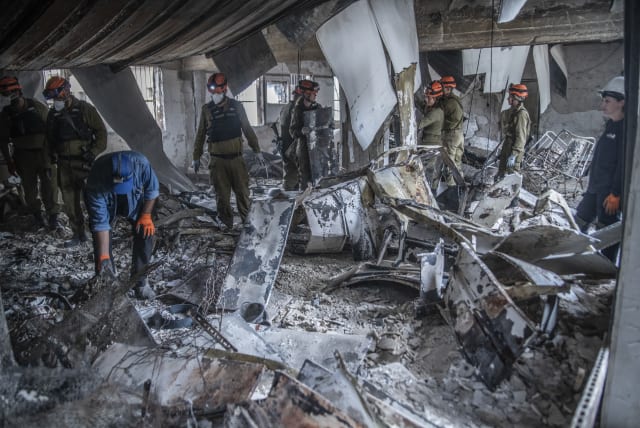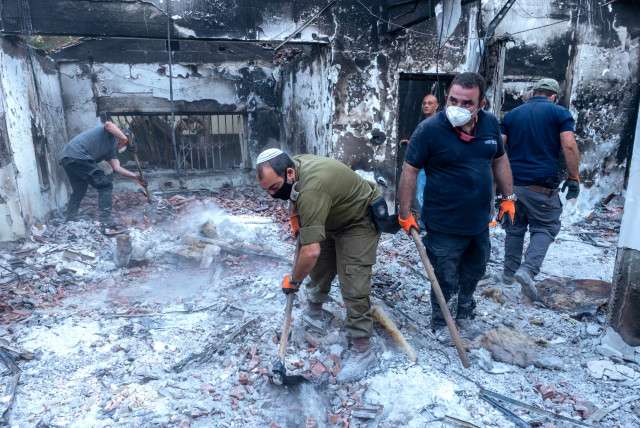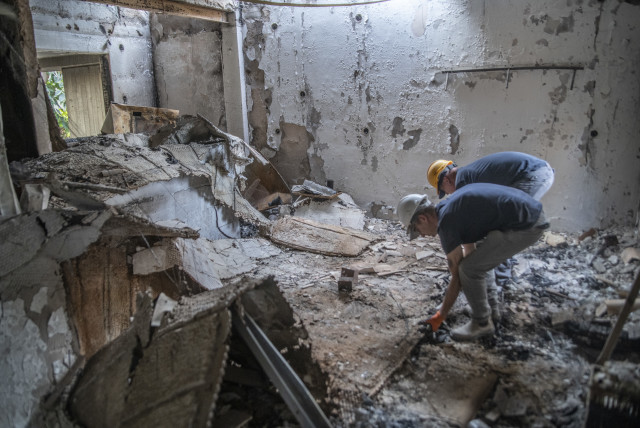Unearthing tragedy: Archaeologists search for remnants of Hamas victims

Amidst the chaos of ash, twisted wire, and blackened timber, Israel Antiquities Authority archaeologists hope to find a remnant of those who perished on October 7.
As you enter Kibbutz Beeri, a place once lush and vibrant, the air is now tainted with the grim scent of death. The houses, once standing tall, lie broken and charred.
An officer advises caution.
"Watch your step," he said, as the archaeologists still need to complete their delicate task.
Their mission: Amidst the chaos of ash, twisted wire, and blackened timber that defies adequate description, these archaeologists hope to find a remnant of those who perished on October 7 to provide closure to families still searching for their loved ones.
There are still at least 100 missing people.
Archaeologists from the Israel Antiquities Authority (IAA) joined the search for missing individuals within the houses and vehicles that were consumed by the Hamas massacre just over a month ago.
"They have been employing the techniques and the knowledge they have acquired in archaeological excavations of burnt and destroyed ancient sites and have discovered many signs of human remains in the hope that they will provide certain evidence for the families regarding the fate of their dear ones," the IAA explained.
The archaeologists, who also included international volunteers, are meticulously sifting through the ash, painstakingly examining the charred remnants of homes where families from Kibbutz Beeri, Kfar Aza, and Nir Oz met their tragic end. They are also investigating the contents of the vehicles from the gathering at Kibbutz Re'im. Initially, the archaeologists formed teams to search for any traces of missing individuals. However, it soon became evident that their archaeological techniques could reveal previously undiscovered remains. Consequently, they expanded their efforts to include the examination of the burnt houses and vehicles.
Archaeological methods are applicable
"The archaeological methods employed at ancient sites are similar to the methods applied here, but it is one thing to expose 2,000-year-old destruction remains, and quite another thing—heart-rending and unfathomable—to carry out the present task searching for evidence of our sisters and brothers in the settlements," IAA archaeologists said.
They said they had found specific evidence of at least 10 deceased persons previously considered missing. Some have been buried, but others were transferred for examination on the Shura Base or the Abu Kabir Forensic Institute.
At Abu Kabir, a small team of forensic scientists receive these findings and aim to determine if enough DNA can be scraped from them to determine a person's identity.
Prof. Tal Simmons, a professor in the Department of Forensic Science at Virginia Commonwealth University's College of Humanities and Sciences, leads the project. She is an Israeli citizen who told The Jerusalem Post, "I could not sit home" and wanted to join Israel in recovering from the massacre.
Today, she sits in a tiny room in the basement of Abu Kabir. The walls are white. The smell is a mix of formaldehyde, death, and cleaning supplies.
"We received five boxes like this from different places in Alumim," Simmons said, pointing to a set of small cardboard boxes, each just about the size of a package of six shot glasses. "We think these are the Thai workers."
Inside each box are the pieces discovered by archaeologists and thought to be the bones of people burnt in their homes. On one package, it says, "Kibbutz Amirim, Apartment 3."
Simmons opened the box, whose insides look like what a six-year-old girl would gather from the park and insist on keeping for her imaginary pet.
"Is there one person per box?" The Jerusalem Post asked.
"Right now, we're going through each box, trying to see what pieces are identifiable. And then to make sure there is not more than one individual per box," Simmons responded.
On the wooden table in front of Simmons were several more gray boxes. She picked one up: "This is a small piece of a right foot," she noted. "These bones here, they are parts of bigger bones."
The people were doused with lighter fluid and burnt at temperatures upwards of 700 degrees Celcius, she explained. As such, in most cases, "there is nothing organic left," Simmon sighed.
"Then she touched a small knob that was a bright brown more than a gray. She put it to the side to take a sample that could be sent upstairs to the lab for testing.
If the team is successful, then one more family will have closure. If not, they will have to resift through the box of bone pieces in hopes of finding another option.
"I've worked in war zones worldwide," Simmons told the Post. "I've dealt with a lot of skeletal remains. I think the only time I ever dealt with anything that was as burned as these were was from a helicopter crash in Bosnia.
"This is a really, really unique, horrible situation where the houses and outposts, everything was set on fire, and they burned for a long time without any fire suppression," she continued.
"But we're working with this because this is what we've got."
Jerusalem Post Store
`; document.getElementById("linkPremium").innerHTML = cont; var divWithLink = document.getElementById("premium-link"); if (divWithLink !== null && divWithLink !== 'undefined') { divWithLink.style.border = "solid 1px #cb0f3e"; divWithLink.style.textAlign = "center"; divWithLink.style.marginBottom = "15px"; divWithLink.style.marginTop = "15px"; divWithLink.style.width = "100%"; divWithLink.style.backgroundColor = "#122952"; divWithLink.style.color = "#ffffff"; divWithLink.style.lineHeight = "1.5"; } } (function (v, i) { });


